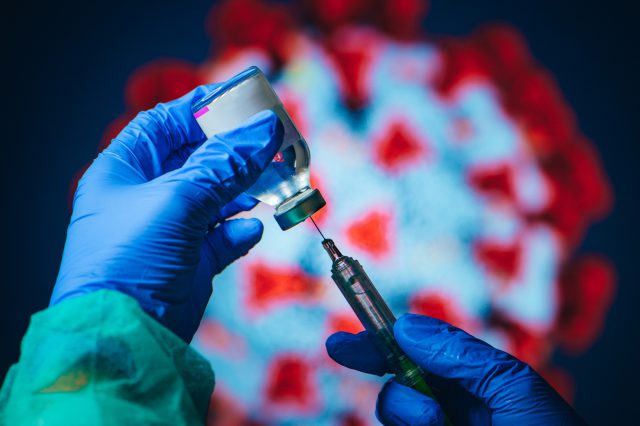Vaccinating upwards of 300 million Americans is a daunting logistical challenge. According to the World Health Organization, a successful immunization program is built on “functional, end-to-end supply chain and logistics systems.” A lot goes on between manufacturing a brand new vaccine and getting it into the arms of patients.

“It’s an evolving process and a story of shifting bottlenecks,” explained Nikolay Osadchiy, associate professor, Information Systems & Operations Management, who has been paying close attention to the vaccine rollout. “Overall, from the vaccine development to the ongoing immunization, it’s been an incredible process with great progress.”
In late February, the Food and Drug Administration gave Johnson & Johnson the thumbs up for its coronavirus vaccine, paving the way for the company to join forces with the Moderna and Pfzier-BioNTech coronavirus vaccines, both of which were approved by the FDA in late 2020. “It’s good to see that these companies are working preemptively to keep [a manufacturing] bottleneck from happening,” Osadchiy added. According to Bloomberg.com, with the addition of the Johnson & Johnson vaccine, the U.S. should have enough doses to fully vaccinate 130 million Americans by late March.
Contract Manufacturing’s Role in Ramping Up Production
To meet the demand for their coronavirus vaccines, both Moderna and Pfizer-BioNTech have outsourced various aspects of their vaccine production to contract manufacturers. In January, Novartis signed a deal with Pfizer-BioNTech to receive bulk mRNA from the drug maker and fill the active ingredient into vials at its state of the art “aseptic” manufacturing plant in Stein, Switzerland, before shipping the vials back to Pfizer-BioNTech for distribution around the world. According to ContractPharma.com, Novartis is in talks with several other companies to provide similar manufacturing capabilities.
Likewise, Moderna has teamed up with Lonza, a global pharmaceutical contract manufacturer, to use its production capacity in the U.S. and Switzerland. In early March, the White House announced that pharmaceutical company Merck would help produce the Johnson & Johnson vaccine. Utilizing contract manufacturers to increase capacity comes at a premium. Osadchiy has talked with several major industry players and noted, “It’s a good time to be in the contract manufacturing business, as prices for their services have increased by up to 400%.”
To pay for increased vaccine administration capacity, states and local health systems have used financial resources earmarked for vaccine distribution via the stimulus bills passed by Congress. There is more money budgeted for vaccination efforts in the $1.9 trillion stimulus bill making its way through Congress now. “Money helps,” added Osadchiy.
Simplifying the Supply Chain with the Johnson & Johnson Vaccine
While the Johnson & Johnson vaccine may have different efficacy than the Moderna and Pfizer-BioNTech in preventing COVID-19 (it has a 66 percent rate of preventing moderate cases of COVID-19 while the other vaccines both exceed 90 percent), the Johnson & Johnson vaccine does boast 100 percent effectiveness against severe infection and death from COVID-19. It is also a single dose vaccine that requires nothing more than regular refrigeration. “Johnson & Johnson’s one dose vaccine does have appealing points,” explained Osadchiy. “We can prevent deaths with this vaccine, roll out vaccination more broadly, and get to herd immunity sooner.”
Coronavirus Variants Create Challenges
Dr. Anthony Fauci, chief medical advisor to President Joe Biden, believes that the coronavirus has undergone thousands of mutations since first being detected in humans. As a result, it’s likely that the coronavirus epidemic will become an endemic disease, one that is always present in the population and where booster shots are a constant necessity. That’s the bad news.
The good news? “These companies are already working on booster shots,” Osadchiy said.
The Effect of “No Shows” on Patient Behavior
Key to the effectiveness of the mass vaccination process is people’s behavior, noted Osadchiy. Even though vaccine manufacturing is on the increase, demand for vaccines exceeds available doses. As a result, people often look at multiple sites for inoculation appointments. If they book multiple appointments and show up for the first available, that can be a problem. When a patient forgets to cancel those unnecessary appointments, “capacity is wasted,” said Osadchiy.

In a 2016 research paper, “Are Patients Patient? The Role of Time to Appointment on Patient Flow,” Osadchiy teamed up with Diwas KC, professor of Information Systems & Operations Management, to study the effect of no shows on outpatient healthcare delivery. “We need to be proactive about how to manage no shows or multiple bookings,” Osadchiy said, suggesting that healthcare systems and vaccination sites utilize a “centralized queue” for appointments. “When people know they have a place in the queue, they are less likely to shop around,” Osadchiy explained. “Systems where slots for vaccines are released periodically and at somewhat unpredictable times create anxiety. So, people check multiple providers and schedule appointments with multiple providers. It’s important to avoid that.”
More controversial, noted Osadchiy, is deliberate overbooking for vaccinations to avoid wasting capacity due to no shows. “If done right, overbooking shouldn’t be noticed by patients,” said Osadchiy. “You’ll need to overbook very carefully and still provide vaccines to everyone on the same day you said you’d provide it. Otherwise, there will be a snowballing effect.”
Another potential roadblock is logistical coordination between the first and second shots for the two-dose vaccines, which need to be delivered 21 to 28 days apart, depending on which brand of vaccine a patient receives. “Luckily we have three to four weeks of lead time,” said Osadchiy. “There have been some reports of patients getting bumped from their second dose appointments, but in my opinion, this is totally preventable with planning—and barring a natural disaster.”
Ramping up Production of Vaccine-Adjacent Supplies
Products like syringes, glass vials, and the personal protective equipment necessary to distribute the vaccine are in high demand, but Osadchiy expects supply to keep pace with demand. “Free markets work well,” he explained. “Prices are at a premium. Manufacturers have a natural incentive to shift their capacity in those directions.”
“Give credit where credit is due.”
According to John Hopkins University of Medicine, vaccine development, on average, takes 5-10 years or more. That the coronavirus vaccine rollout is likely, at least in the U.S., to lead to herd immunity within two years of the virus’s appearance within the U.S. “is a very big achievement,” said Osadchiy. “From science, from manufacturing, from supply chain—all of it.” While there has been—and continues to be—a learning curve, “We need to give credit where credit is due,” Osadchiy added. ”Things are looking up. I am optimistic.”
Learn more about Goizueta’s faculty and research for Information Systems & Operations Management.











